Influence of Seed-Covering Layers on Caper Seed Germination
Abstract
1. Introduction
2. Results and Discussion
2.1. Viability and Germination Tests
2.2. Hormone Content
2.3. Seed Water Uptake
2.4. Puncture Force Needed to Crack the Testa
2.5. Puncture Force Needed to Pierce the Endosperm
3. Materials and Methods
3.1. Plant Material
3.2. Viability and Germination Tests
3.3. Hormone Content
3.4. Seed Water Uptake
3.5. Mechanical Resistance Determination
3.6. Data Analysis
4. Conclusions
Author Contributions
Funding
Data Availability Statement
Acknowledgments
Conflicts of Interest
References
- Sottile, F.; Caltagirone, C.; Peano, C.; Del Signore, M.B.; Barone, E. Can the caper (Capparis spinosa L.) still be considered a difficult-to-propagate Crop? Horticulturae 2021, 7, 316. [Google Scholar] [CrossRef]
- Sozzi, G.O.; Peter, K.V.; Nirmal Babu, K.; Divakaran, M. Capers and caperberries. In Handbook of Herbs and Spices: Second Edition; Woodhead Publishing: Sawston, UK, 2012; Volume 2, pp. 193–224. ISBN 9780857095688. [Google Scholar]
- Foschi, M.L.; Juan, M.; Pascual, B.; Pascual-Seva, N. The imbibition, viability, and germination of caper seeds (Capparis spinosa L.) in the first year of storage. Plants 2022, 11, 202. [Google Scholar] [CrossRef] [PubMed]
- Munir, M.; Ahmad, M.; Saeed, M.; Waseem, A.; Nizami, A.-S.; Sultana, S.; Zafar, M.; Rehan, M.; Srinivasan, G.R.; Ali, A.M.; et al. Biodiesel production from novel non-edible caper (Capparis spinosa L.) seeds oil employing Cu–Ni doped ZrO2 catalyst. Renew. Sustain. Energy Rev. 2021, 138, 110558. [Google Scholar] [CrossRef]
- Liu, K.; Devarajan, Y.; Nithyanantham, V.; Nalla, B.T.; Krishnamurthy, V. An experimental study on transesterification process and emission analysis of diesel engine propelled with Capparis spinosa biodiesel. Biomass Convers. Biorefinery 2021, 1–8. [Google Scholar] [CrossRef]
- Lozano, J. El Alcaparro; Ministerio de Agricultura: Madrid, Spain, 1977. [Google Scholar]
- Corner, E.J.H. The Seeds of Dicotyledons; Cambridge University Press: Cambridge/London, UK, 1976; ISBN 052120688x. [Google Scholar]
- Leubner-Metzger, G. Functions and regulation of β-1,3-glucanases during seed germination, dormancy release and after-ripening. Seed Sci. Res. 2003, 13, 17–34. [Google Scholar] [CrossRef]
- Bewley, J.D.; Bradford, K.J.; Hilhorst, H.W.M.; Nonogaki, H. Seeds: Physiology of Development, Germination and Dormancy, 3rd ed.; Springer: New York, NY, USA, 2013; ISBN 978-1-4614-4692-7. [Google Scholar]
- Baskin, J.M.; Baskin, C.C. A classification system for seed dormancy. Seed Sci. Res. 2004, 14, 1–6. [Google Scholar] [CrossRef]
- Sozzi, G.O.; Chiesa, A. Improvement of caper (Capparis spinosa L.) seed germination by breaking seed coat-induced dormancy. Sci. Hortic. 1995, 62, 255–261. [Google Scholar] [CrossRef]
- Foschi, M.L.; Juan, M.; Pascual, B.; Pascual-Seva, N. Water uptake and germination of caper (Capparis spinosa L.) seeds. Agronomy 2020, 10, 838. [Google Scholar] [CrossRef]
- Pascual, B.; San Bautista, A.; Imbernón, A.; López-Galarza, S.; Alagarda, J.; Maroto, J.V. Seed treatments for improved germination of caper (Capparis spinosa). Seed Sci. Technol. 2004, 32, 637–642. [Google Scholar] [CrossRef]
- Juan, M. Estudio Para la Mejora de las Técnicas de Propagación de la Alcaparra (Capparis spinosa L.). Ph.D. Thesis, Universitat Politècnica de València, Valencia, Spain, 2017. [Google Scholar]
- Finch-Savage, W.E.; Leubner-Metzger, G. Seed dormancy and the control of germination. New Phytol. 2006, 171, 501–523. [Google Scholar] [CrossRef]
- Martin, A.C. The comparative internal morphology of seeds. Am. Midl. Nat. 1946, 36, 513–660. [Google Scholar] [CrossRef]
- Steinbrecher, T.; Leubner-Metzger, G. The biomechanics of seed germination. J. Exp. Bot. 2017, 68, 765–783. [Google Scholar] [CrossRef] [PubMed]
- Foschi, M.L.; Juan, M.; Pascual, B.; Pascual-Seva, N. Collection guidelines to achieve a viable caper commercial propagation. Agronomy 2022, 12, 74. [Google Scholar] [CrossRef]
- Moghaddasi Mohammad, S.; Kashani, H.H.; Azarbad, Z. Capparis spinosa L. Propagation and Medicinal uses. Life Sci. J. 2012, 9, 684–686. [Google Scholar]
- Müller, K.; Tintelnot, S.; Leubner-Metzger, G. Endosperm-limited Brassicaceae Seed Germination: Abscisic Acid Inhibits Embryo-induced Endosperm Weakening of Lepidium sativum (cress) and Endosperm Rupture of Cress and Arabidopsis thaliana. Plant Cell Physiol. 2006, 47, 864–877. [Google Scholar] [CrossRef]
- Pascual, B.; San Bautista, A.; López-Galarza, S.; Alagarda, J.; Maroto, J.V. Germination behavior after storage of caper seeds. Seed Sci. Technol. 2006, 34, 151–159. [Google Scholar] [CrossRef]
- Baskin, C.C.; Baskin, J.M. Seeds: Ecology, Biogeography, and Evolution of Dormancy and Germination, 2nd ed.; Academic Press: San Diego, CA, USA, 2014; ISBN 978-0-12-416683-7. [Google Scholar]
- Ellis, R.H.; Hong, T.D.; Roberts, E.H. Handbook of Seed Technology for Genebanks; CGIAR: Rome, Italy, 1985. [Google Scholar]
- Chalak, L.; Elbitar, A.; Cordahi, N.; Hage, C.; Chehade, A. In vitro propagation of Capparis spinosa L. Acta Hortic. 2003, 616, 335–338. [Google Scholar] [CrossRef]
- Elazazi, E.M. Effective methods to improvement Capparis spinosa L. (Caper) seeds germination by breaking seed dormancy in Qatar gene bank. In Proceedings of the Qatar Foundation Annual Research Conference Proceedings, Doha, Qatar, 22–23 May 2016. [Google Scholar]
- Webster, R.E.; Waterworth, W.M.; Stuppy, W.; West, C.E.; Ennos, R.; Bray, C.M.; Pritchard, H.W. Biomechanical, biochemical, and morphological mechanisms of heat shock-mediated germination in Carica papaya seed. J. Exp. Bot. 2016, 67, 6373–6384. [Google Scholar] [CrossRef]
- ISTA. International Seed Testing Association (ISTA); ISTA Rules; ISTA: Bassersdorf, Switzerland, 2018; ISSN 2310-3655. [Google Scholar]
- Imbernón, A. Mejora de las Técnicas de Propagación Sexual y Vegetativa de la Alcaparra (Capparis spinosa L.), Trabajo Fin de Carrera; Universidat Politècnica de València: Valencia, Spain, 2000. [Google Scholar]
- Foschi, M.L.; Juan, M.; Pascual, B.; Pascual-Seva, N. Gibberellins improve caper seeds germination: Guidelines for their application. Acta Hortic. 2023, in press. [Google Scholar]
- Lepengue, A.N.; Muluway Kalenda, A.; Daouda, K.; Ake, S.; Yatty Kouadio, J.Y.; Zouzou, M.; M’Batchi, B. Gibbrelic acid effect on Hibiscus sabdariffa L. var. sabdariffa growth in Gabon. J. Appl. Biosci. 2012, 49, 3435–3443. [Google Scholar]
- Nowruzian, A.; Aalami, A. Effect of different treatments on dormancy breaking for seed germination enhancement and metabolite analysis of Capparis spinosa L. J. Med. Plants By-Prod. 2022, 1–12. [Google Scholar]
- Yuxi, Z.; Yanchao, Y.; Zejun, L.; Tao, Z.; Feng, L.; Chunying, L.; Shupeng, G. GA3 is superior to GA4 in promoting bud endodormancy release in tree peony (Paeonia suffruticosa) and their potential working mechanism. BMC Plant Biol. 2021, 21, 323. [Google Scholar] [CrossRef] [PubMed]
- Yamaguchi, S. Gibberellin metabolism and its regulation. Annu. Rev. Plant Biol. 2008, 59, 225–251. [Google Scholar] [CrossRef]
- Magome, H.; Nomura, T.; Hanada, A.; Takeda-Kamiya, N.; Ohnishi, T.; Shinma, Y.; Katsumata, T.; Kawaide, H.; Kamiya, Y.; Yamaguchi, S. CYP714B1 and CYP714B2 encode gibberellin 13-oxidases that reduce gibberellin activity in rice. Proc. Natl. Acad. Sci. USA 2013, 110, 1947–1952. [Google Scholar] [CrossRef] [PubMed]
- Davies, F.T.; Geneve, R.L.; Wilson, S.B. Hartmann and Kester’s Plant Propagation Principles and Practices, 9th ed.; Pearson Education: New York, NY, USA, 2018; ISBN 13: 978-0-13-448089-3. [Google Scholar]
- Matilla, A.J. Desarrollo y germinación de las semillas. In Fundamentos de Fisiología Vegetal; Azcón-Bieto, J., Talón, M., Eds.; McGRAW-HILL–Interamericana, S.L./Publicacions i Edicions de la Universitat De Barcelona: Madrid/Barcelona, Spain, 2013; pp. 537–558. ISBN 978-84-481-5168-3. [Google Scholar]
- Miransari, M.; Smith, D.L. Plant hormones and seed germination. Environ. Exp. Bot. 2014, 99, 110–121. [Google Scholar] [CrossRef]
- Pascual, B.; San Bautista, A.; Ferreros, N.; López-Galarza, S.; Maroto, J.V. Analysis of germination of caper seeds as influenced by the position of fruit on the mother plant, fruit maturation stage and fruit weight. J. Hortic. Sci. Biotechnol. 2003, 78, 73–78. [Google Scholar]
- Torres, M.; Frutos, G. Logistic function analysis of germination behaviour of aged fennel seeds. Environ. Exp. Bot. 1990, 30, 383–390. [Google Scholar] [CrossRef]
- Causton, D.R.; Venus, J.C. Single leaf growth and the Richards function: Methodology. In The Biometry of Plant Growth; Edward Arnold: London, UK, 1981; pp. 87–143. ISBN 978-0-7131-2812-3. [Google Scholar]
- Seo, M.; Jikumaru, Y.; Kamiya, Y. Profiling of Hormones and Related Metabolites in Seed Dormancy and Germination Studies. In Seed Dormancy. Methods in Molecular Biology; Kermode, A., Ed.; Humana: Louisville, KY, USA, 2011; pp. 99–111. [Google Scholar]
- Zhang, Y.; Chen, B.; Xu, Z.; Shi, Z.; Chen, S.; Huang, X.; Chen, J.; Wang, X. Involvement of reactive oxygen species in endosperm cap weakening and embryo elongation growth during lettuce seed germination. J. Exp. Bot. 2014, 65, 3189–3200. [Google Scholar] [CrossRef]
- Statistical Graphics Corporation. Statgraphics Statistical Graphics Statgraphics Centurion XVIII; Statistical Graphics Corporation: Rockville, MY, USA, 2018. [Google Scholar]
- Sileshi, G.W. A critique of current trends in the statistical analysis of seed germination and viability data. Seed Sci. Res. 2012, 22, 145–159. [Google Scholar] [CrossRef]
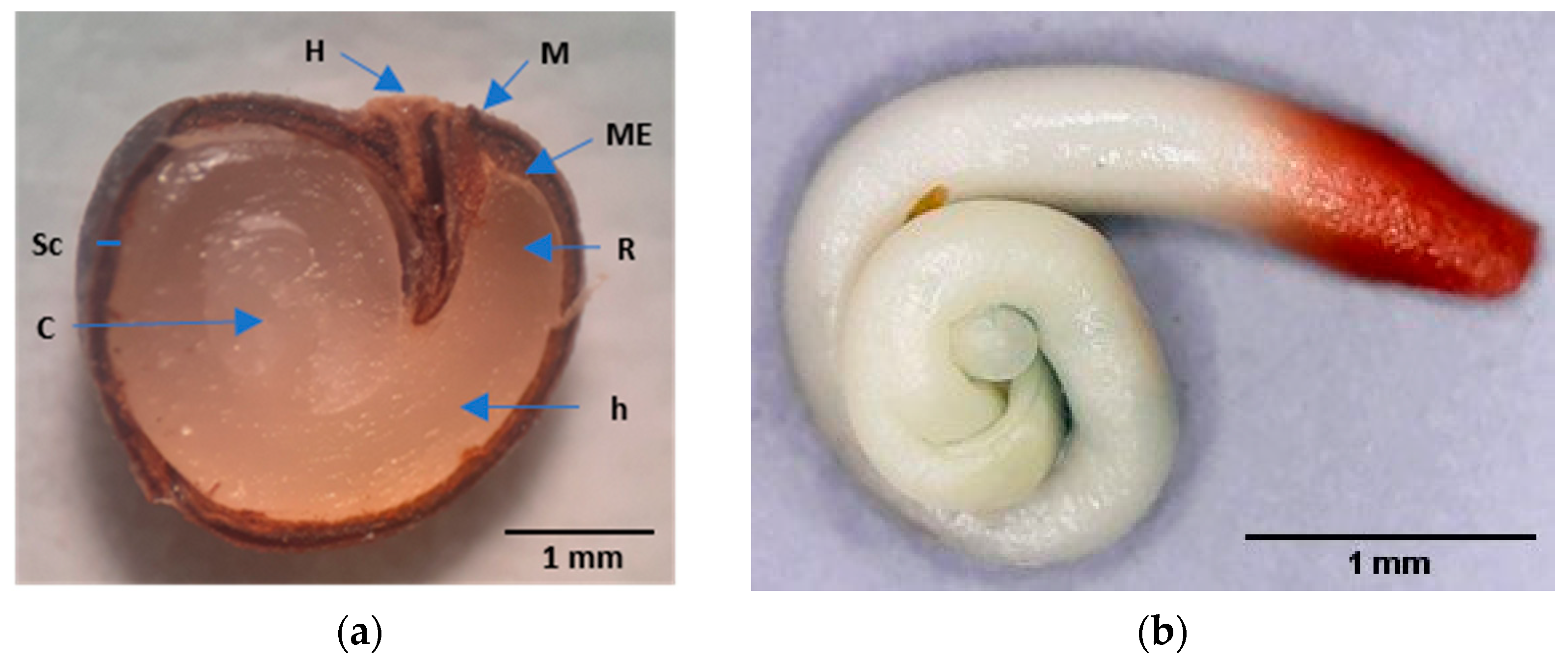

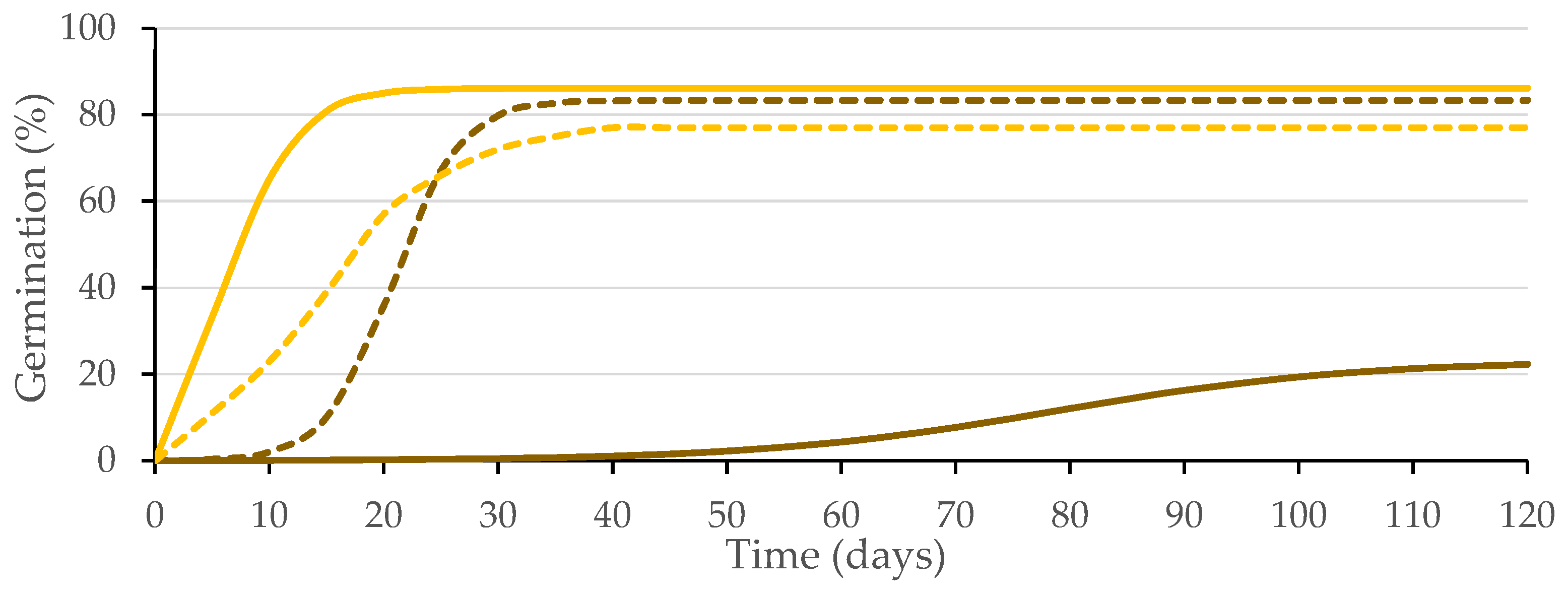

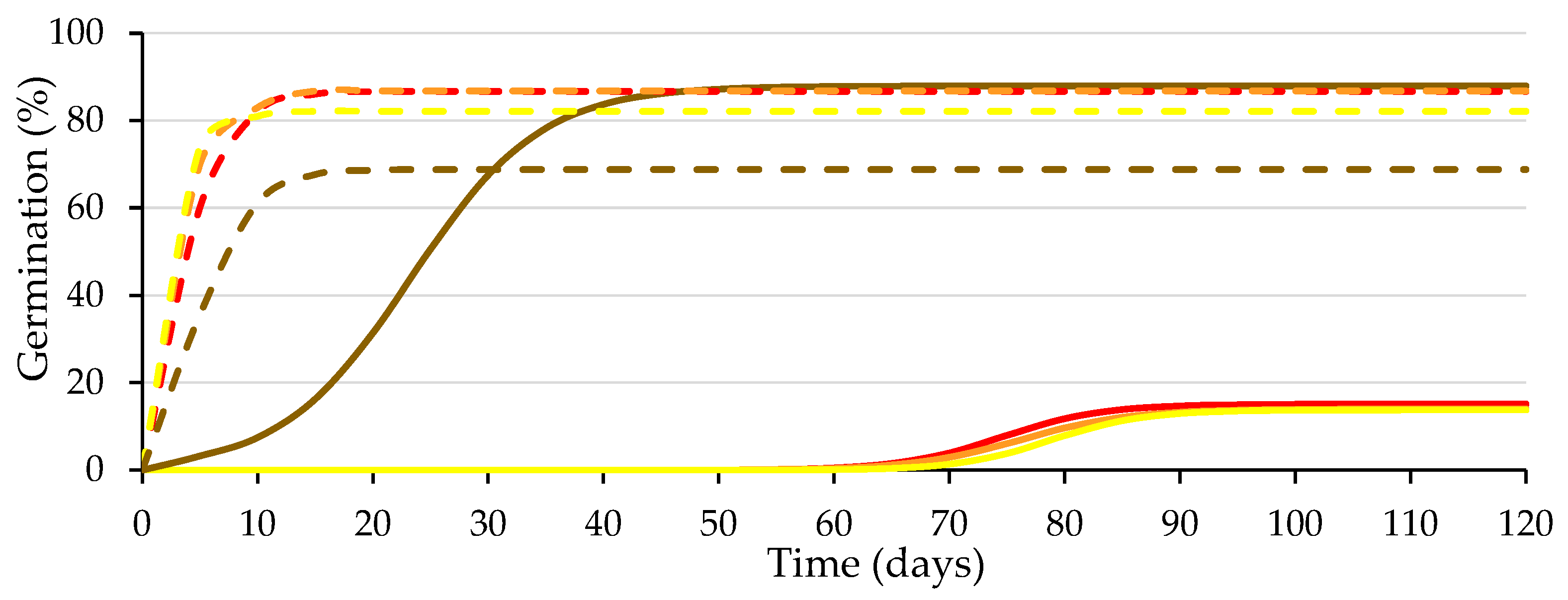

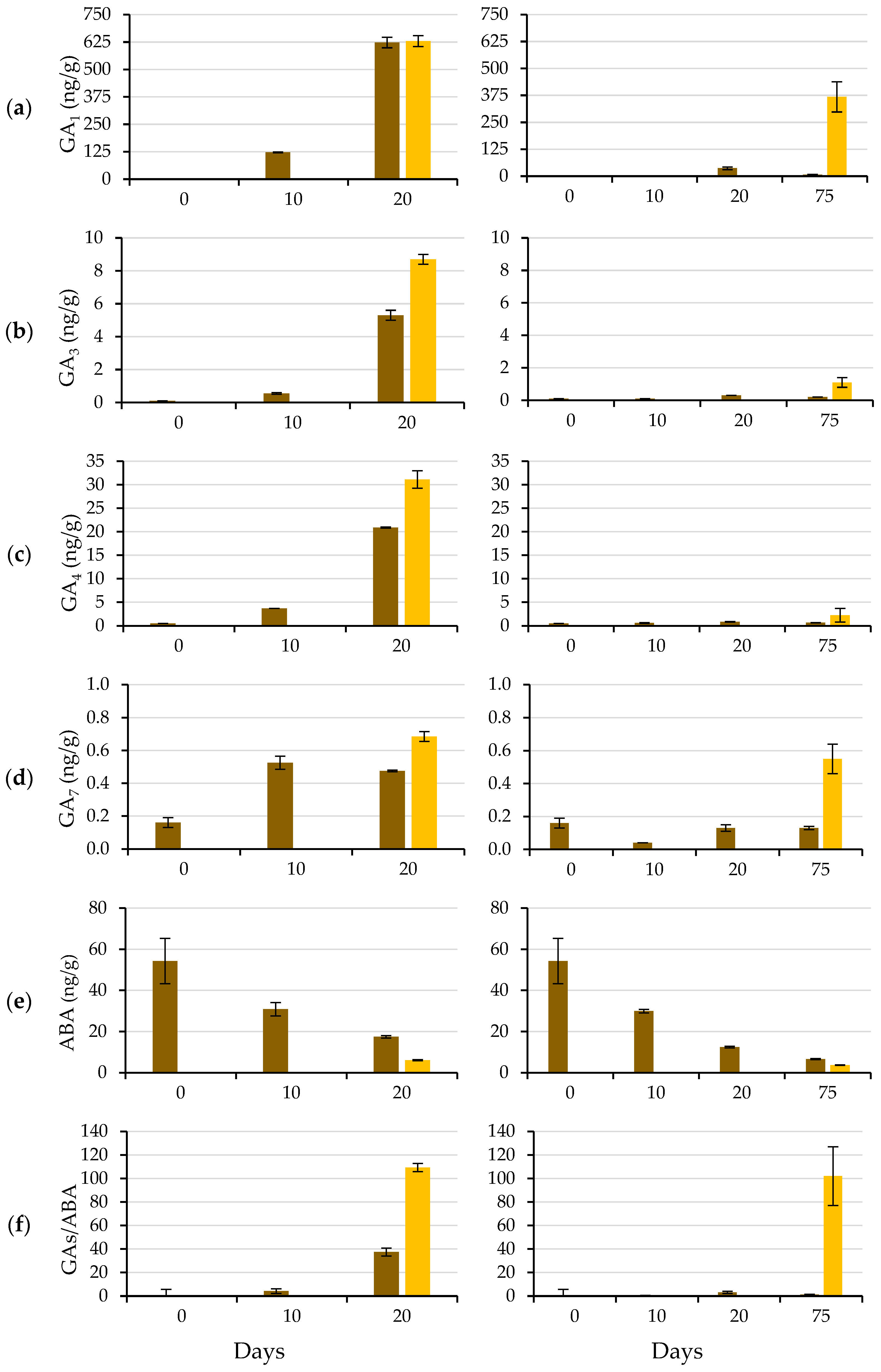
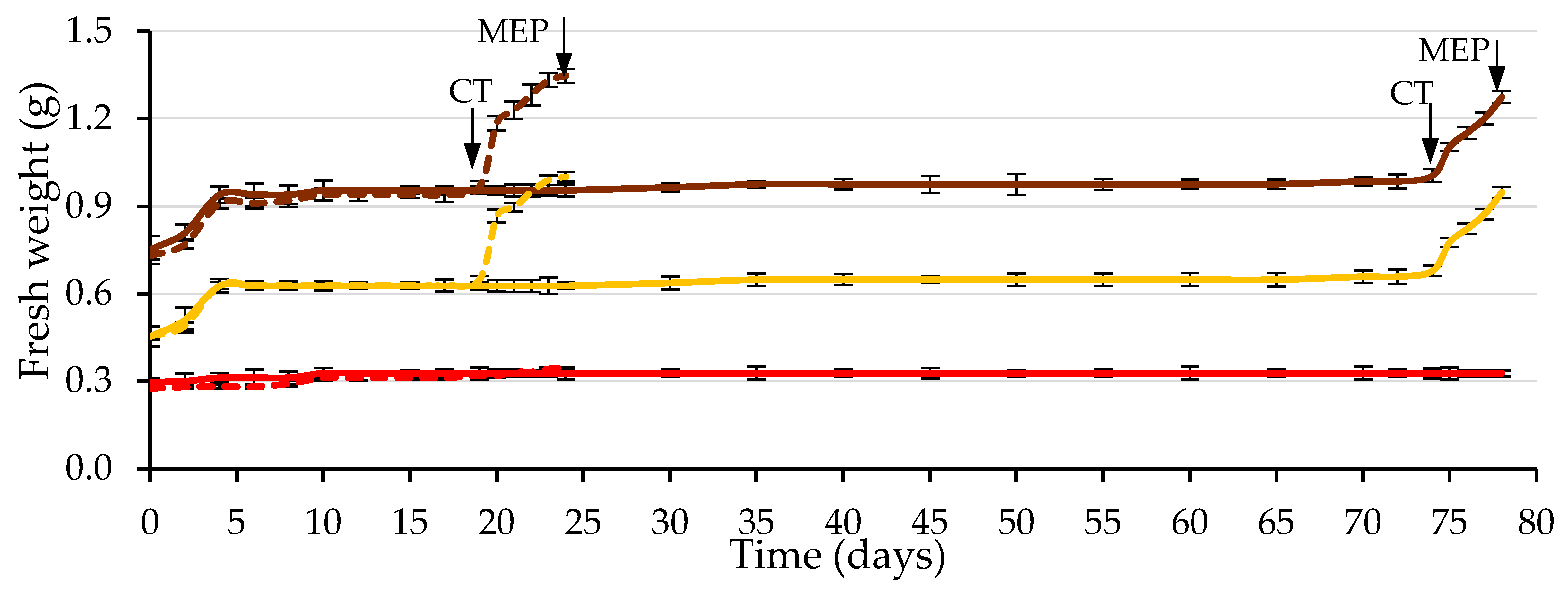
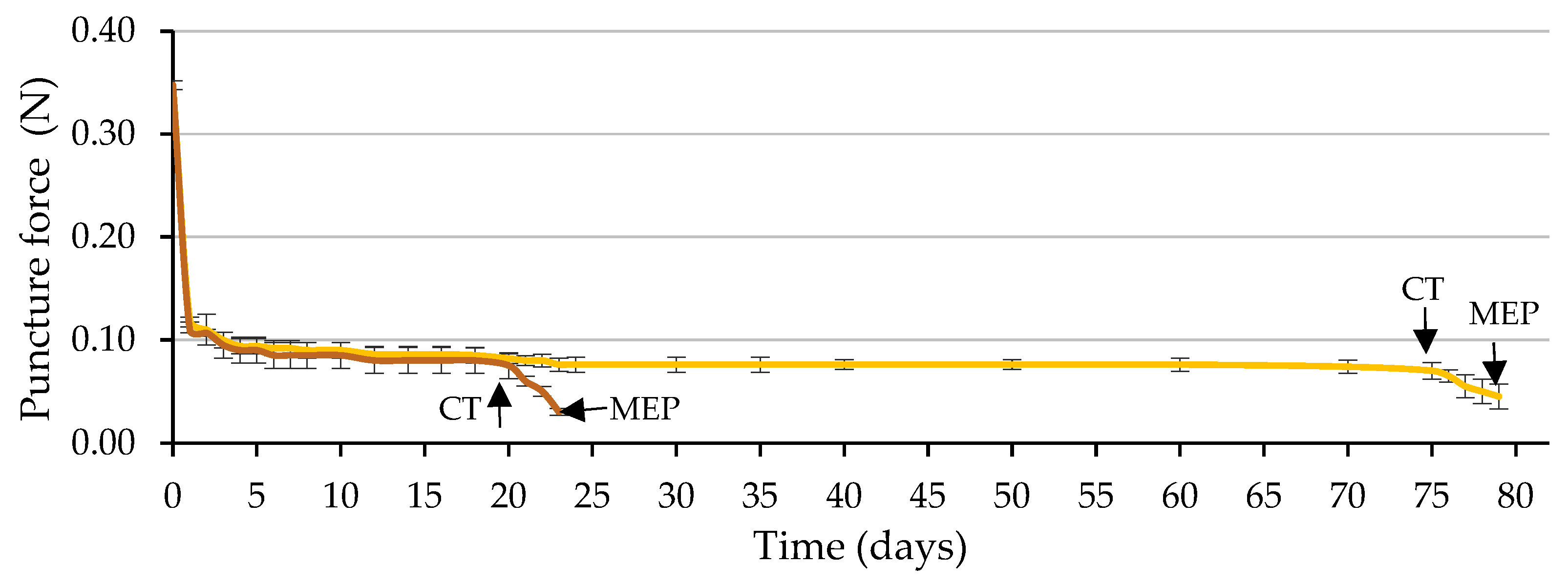

| A | Gt50 | k/2 | |
|---|---|---|---|
| Testa (T) | |||
| With testa | 52.78 b | 49.06 a | 0.113 |
| Without testa | 81.61 a | 13.42 b | 0.126 |
| Solution (S) | |||
| Water | 54.16 b | 43.24 a | 0.109 |
| GA3 | 80.22 a | 19.25 b | 0.130 |
| Analysis of variance | |||
| Factors (degrees of freedom) | % Sum of squares | ||
| T (1) | 30.05 ** | 40.01 ** | 0.64 NS |
| S (1) | 24.55 ** | 18.12 ** | 1.52 NS |
| T × S (1) | 44.43 ** | 32.43 ** | 29.52 NS |
| Residual (12) | 0.97 | 9.44 | 68.33 |
| Standard deviation (+) | 3.00 | 9.99 | 0.08 |
| A | Gt50 | k/2 | |
|---|---|---|---|
| Testa (T) | |||
| With testa | 32.69 b | 63.86 a | 0.247 b |
| Without testa | 82.07 a | 3.37 b | 1.032 a |
| GA3 Concentration (C) | |||
| 0 | 50.89 b | 39.21 a | 0.205 b |
| 5 | 52.30 b | 40.06 a | 0.990 ab |
| 50 | 47.96 b | 40.36 a | 1.219 a |
| 500 | 78.38 a | 15.00 b | 0.145 b |
| Analysis of variance | |||
| Factors (Degrees of freedom) | % Sum of squares | ||
| T (1) | 52.00 ** | 77.30 ** | 15.14 * |
| C (3) | 12.74 ** | 9.78 ** | 21.91 * |
| T × C (3) | 33.57 ** | 11.92 ** | 13.12 NS |
| Residuals (24) | 1.68 | 1.00 | 49.83 |
| Standard deviation (+) | 5.12 | 15.3 | 0.8 |
| Puncture Force (N) | |
|---|---|
| Imbibition period (P) | |
| 0 | 2.83 |
| 4 | 2.87 |
| 20 | 2.89 |
| Solution (S) | |
| Water | 2.88 |
| GA3 | 2.85 |
| Analysis of variance | |
| Factors (Degrees of freedom) | % Sum of squares |
| P (2) | 4.29 NS |
| S (1) | 1.31 NS |
| P × S (2) | 1.93 NS |
| Residuals (18) | 92.47 |
| Standard deviation (+) | 0.13 |
| Puncture Force (N) | |
|---|---|
| Testa (T) | |
| Uncracked | 0.080 a |
| Cracked | 0.039 b |
| Solution (S) | |
| Water | 0.065 |
| GA3 | 0.054 |
| Analysis of variance | |
| Factors (Degrees of freedom) | % Sum of squares |
| T (1) | 73.23 ** |
| S (1) | 5.45 NS |
| T × S (1) | 1.68 NS |
| Residual (12) | 19.64 |
| Standard deviation (+) | 0.01 |
Disclaimer/Publisher’s Note: The statements, opinions and data contained in all publications are solely those of the individual author(s) and contributor(s) and not of MDPI and/or the editor(s). MDPI and/or the editor(s) disclaim responsibility for any injury to people or property resulting from any ideas, methods, instructions or products referred to in the content. |
© 2023 by the authors. Licensee MDPI, Basel, Switzerland. This article is an open access article distributed under the terms and conditions of the Creative Commons Attribution (CC BY) license (https://creativecommons.org/licenses/by/4.0/).
Share and Cite
Foschi, M.L.; Juan, M.; Pascual, B.; Pascual-Seva, N. Influence of Seed-Covering Layers on Caper Seed Germination. Plants 2023, 12, 439. https://doi.org/10.3390/plants12030439
Foschi ML, Juan M, Pascual B, Pascual-Seva N. Influence of Seed-Covering Layers on Caper Seed Germination. Plants. 2023; 12(3):439. https://doi.org/10.3390/plants12030439
Chicago/Turabian StyleFoschi, María Laura, Mariano Juan, Bernardo Pascual, and Nuria Pascual-Seva. 2023. "Influence of Seed-Covering Layers on Caper Seed Germination" Plants 12, no. 3: 439. https://doi.org/10.3390/plants12030439
APA StyleFoschi, M. L., Juan, M., Pascual, B., & Pascual-Seva, N. (2023). Influence of Seed-Covering Layers on Caper Seed Germination. Plants, 12(3), 439. https://doi.org/10.3390/plants12030439






